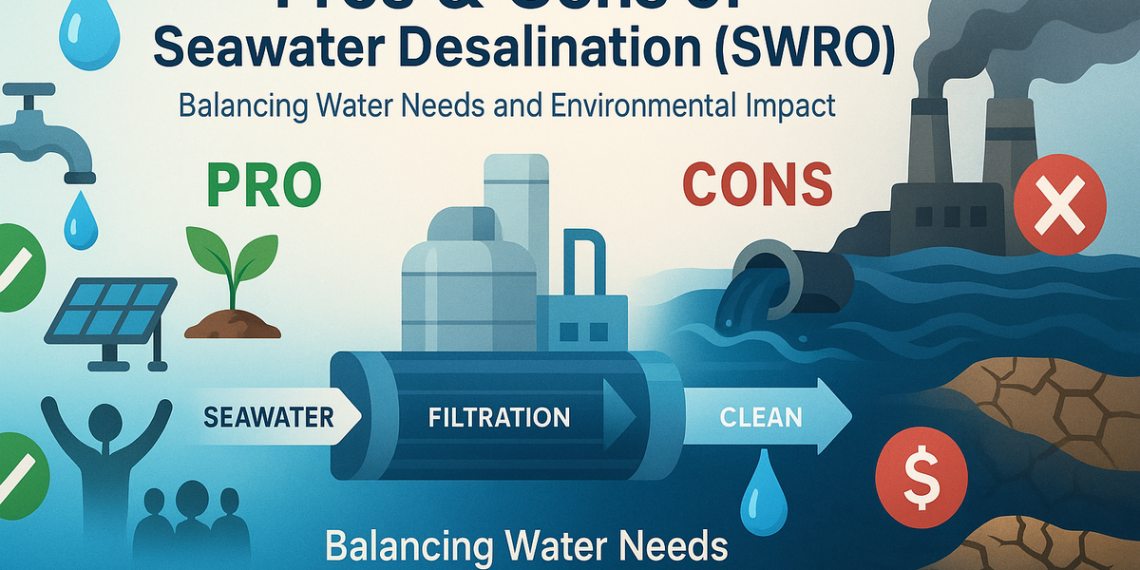Last updated on June 3rd, 2025 at 12:56 pm
As the global demand for freshwater continues to escalate due to population growth, industrialization, and climate change, Seawater Desalination using Reverse Osmosis (SWRO) emerges as a prominent solution. This membrane-based technology has transformed water-scarce regions by converting saline seawater into potable and industrial-grade water. While SWRO systems offer groundbreaking benefits, they also pose distinct challenges that must be acknowledged for informed implementation.
What Is the Seawater Reverse Osmosis (SWRO) Process?
Seawater Reverse Osmosis (SWRO) is a pressure-driven membrane separation process. It involves pumping seawater through a semi-permeable membrane that allows water molecules to pass while rejecting salts, microorganisms, and impurities. This advanced technology is widely used in municipal water supplies, offshore platforms, industrial facilities, and military bases due to its ability to produce high-purity water reliably.
Advantages of Seawater Desalination Using Reverse Osmosis
- Reliable Source of Freshwater
One of the greatest advantages of SWRO is the assurance of constant water supply, especially in arid regions and coastal communities. By tapping into the abundant seawater reserves, nations are no longer solely dependent on rainfall or freshwater bodies.
- High Water Quality Output
SWRO systems can produce ultra-pure water with total dissolved solids (TDS) below 500 ppm, meeting WHO and EPA standards for drinking water. It efficiently removes salts, bacteria, viruses, and harmful organic compounds, ensuring safe water for human consumption and industrial processes.
- Modular and Scalable Technology
SWRO plants can be customized to meet varying capacity demands, ranging from small mobile systems for ships and military use to large-scale municipal desalination plants. This modular scalability makes it feasible for different use cases and budgets.
- Continuous Technological Advancements
With ongoing innovations in membrane material, energy recovery devices (ERDs), and pretreatment technologies, the SWRO process is becoming more energy-efficient and cost-effective. Recent developments have significantly improved membrane durability, fouling resistance, and overall system performance.
- Reduced Footprint Compared to Thermal Methods
Compared to thermal desalination techniques like Multi-Stage Flash (MSF) or Multi-Effect Distillation (MED), SWRO consumes less space and energy, making it suitable for urban environments and remote facilities with limited infrastructure.
- Flexibility in System Integration
SWRO units can be integrated with renewable energy systems such as solar and wind, contributing to sustainable desalination practices and lowering carbon footprints. Hybrid installations are now being adopted to enhance resilience and cost savings.
Challenges and Disadvantages of SWRO Desalination
- High Energy Consumption
One of the primary drawbacks of SWRO is its significant power requirement, typically ranging between 3–6 kWh per cubic meter of water. This makes operation costly and dependent on the availability of energy resources, particularly in off-grid or developing regions.
- Brine Disposal and Environmental Concerns
SWRO produces a high-salinity brine concentrate, which is typically discharged back into the sea. Improper disposal can disrupt marine ecosystems by increasing salinity levels and impacting marine biodiversity, particularly in shallow or enclosed water bodies.
- Membrane Fouling and Scaling
The SWRO membranes are prone to biofouling, scaling, and clogging, which necessitates frequent maintenance, chemical cleaning, and replacement. Inadequate pretreatment can accelerate membrane degradation and reduce system lifespan.
- Capital and Operational Costs
Initial setup costs for SWRO desalination plants can be substantial due to the requirement of high-pressure pumps, energy recovery systems, filtration units, and corrosion-resistant materials. Ongoing operational expenditures (OPEX) include energy, membrane replacements, chemicals, and skilled labor.
- Limited Freshwater Recovery
Typical SWRO systems recover 30–50% of input seawater as freshwater. The rest is discharged as brine. This low recovery ratio means a larger volume of seawater must be processed, increasing energy use and environmental impact.
- Vulnerability to Feedwater Quality
SWRO performance is highly sensitive to feedwater conditions. Red tides, oil spills, and industrial contamination can severely impact membrane operation and lead to emergency shutdowns or costly pretreatment overhauls.
Emerging Trends in SWRO Desalination
- Integration with Renewable Energy
Solar-powered and wind-assisted SWRO systems are gaining momentum to reduce dependency on fossil fuels. Countries like Saudi Arabia and the UAE are investing heavily in zero-emission desalination technologies to meet their sustainability goals.
- Improved Pretreatment Methods
Adoption of Ultrafiltration (UF), Nanofiltration (NF), and advanced oxidation processes (AOPs) in pretreatment stages enhances the longevity and efficiency of RO membranes by reducing organic load, biofouling, and suspended solids.
- Hybrid Desalination Plants
Combining SWRO with thermal desalination units or other water reuse technologies can boost recovery rates and optimize operational costs. Hybrid designs allow better handling of feedwater variations and seasonal fluctuations.
- Smart Monitoring and Automation
Modern SWRO plants utilize AI-based monitoring systems, predictive maintenance, and automated chemical dosing to enhance plant reliability, reduce downtime, and lower human intervention.
Key Industries Benefiting from SWRO Systems
- Municipal Water Supply: Urban centers in water-scarce regions rely on SWRO plants to meet residential needs.
- Oil and Gas: Offshore drilling platforms use compact SWRO systems for freshwater production.
- Hospitality and Resorts: Coastal hotels and islands deploy SWRO systems for self-sustained water production.
- Pharmaceutical and Electronics: Industries requiring ultra-pure water benefit from high-rejection SWRO membranes.
- Military and Emergency Relief: Portable SWRO units are used for rapid response in disaster-struck areas and military bases.
Conclusion: Is SWRO the Future of Desalination?
The Seawater Desalination Reverse Osmosis process offers a reliable, proven, and increasingly efficient method for addressing water scarcity. While energy intensity and environmental impact remain challenges, advances in membrane technology, sustainable integration, and smart system design are paving the way for a more eco-friendly and economically viable future.
As global freshwater demand surges, SWRO stands as a cornerstone of long-term water security, particularly for coastal cities, island nations, and industrial zones. For optimal results, it must be deployed alongside environmental safeguards, renewable energy sources, and robust maintenance protocols.
Where to Buy an SWRO System? Trust AMPAC USA
AMPAC USA is a trustworthy water treatment technology brand with experience of more than 30 years. We make advanced SWRO systems for onshore and offshore use.
The onshore Fresh SWRO Watermakers, designed for land use, can be fed directly from the sea or any beach well and will convert seawater or salty brackish water to pure fresh drinking water. These LandPro ™ systems are perfect for locations with no fresh or municipal water supplies, such as remote areas or smaller atolls and islands having no potable water sources.
SeaPro™ marine offshore fresh watermakers convert seawater fed directly from the sea into drinking water quality and suit most boats, yachts, oceangoing industrial vessels, and military ships.
Trust us when you need a reputed water treatment brand to design, manufacture and deploy Emergency Portable Watermakers, Land-Based Watermakers, Marine Seawater Desalination Products, Military Seawater Desalination products, and Offshore watermakers. Call 909-548-4900 today or visit us here.
References
https://www.ampac1.com/products/seawater-desalination-watermakers
ttps://www.wateronline.com/doc/pros-and-cons-of-seawater-desalination-using-ro-for-drinking-water-0001









